Cracks in the concrete or uneven sidewalks create trip hazards for employees, customers, and passersby. These trip hazards can occur because of a couple different reasons, but what they all have in common is the need to be fixed promptly. While there are preventative measures, most hazards are reactionary. Some issues will be more obvious than others, but you must know how to identify the cause for concrete trip hazard removal to take place.
Concrete is like many materials because it expands in the heat and shrinks in the cold. One large slab of concrete is more likely to crack because of this weather-related expansion and contraction. That leads to not only cracks but also buckling and breaks. For this reason, smaller slabs are installed with intentional splits or cracks that are evenly spaced. Those are called expansion joints, allowing the concrete to keep its integrity and strength.
It is almost impossible to prevent concrete from cracking at all, meaning it is only a matter of time before a split happens. Poor construction practices can lead to this happening sooner rather than later, possibly from an incorrect cement mixture or not allowing the slab to cure properly.
Even the best sidewalks and slabs will eventually give in to the threat of Michigan winters, where freezing and thawing create repeated expansions and contractions. Concrete with cracks already present can exacerbate the problem, as the crack allows water in, which itself will expand and force concrete to split.
Perhaps the cracks have nothing to do with the temperatures, but has something to do with the soil below. If the soil was not properly compacted, it can leave a void where air is trapped. The soil eventually fills those gaps, and the lack of proper support will cause the slab to crack, or sink and become unlevel.
Trip hazards are a threat to anyone who travels along that pathway. Whether it is on private or public property, major liability cases can result from an injury because of a crack in the concrete. Those that are most susceptible to injury are young children, the elderly, and persons with disabilities.
The Americans with Disabilities Act even has an official definition for what a trip hazard is. It states that trip hazards are defined as a change in any vertical level over 1/4 inch. Trip hazard specifications apply to all federal, state, county and municipal facilities, and the ADA also says that trip hazards must be removed from any public or commercial sidewalk.
Replacing a cracked slab can be a costly expense, because it requires the removal of the old slab and the construction of a new slab. Repairing cracks is possible through a technique called slab jacking, which fills any void beneath the slab so cracks will be less likely to return.
Trip hazards can happen anywhere, but D.C. Byers Company/Grand Rapids can help prevent or fix those trip hazards through any means necessary. Regardless if you want the slab replaced or repaired, the trip hazard needs to be removed before any harm is done.
To get a quote on your concrete restoration needs, call DC Byers Company/Grand Rapids today at (616) 538-7300. Our experience and expertise allow us to assess the damage correctly and plan how to perform the repairs to allow you to use your space properly.
For concrete restoration and repair, DC Byers Company/Grand Rapids looks at all the factors contributing to the deterioration of the concrete. By understanding the underlying problems, we can start working on the most satisfying and cost-effective solutions.
